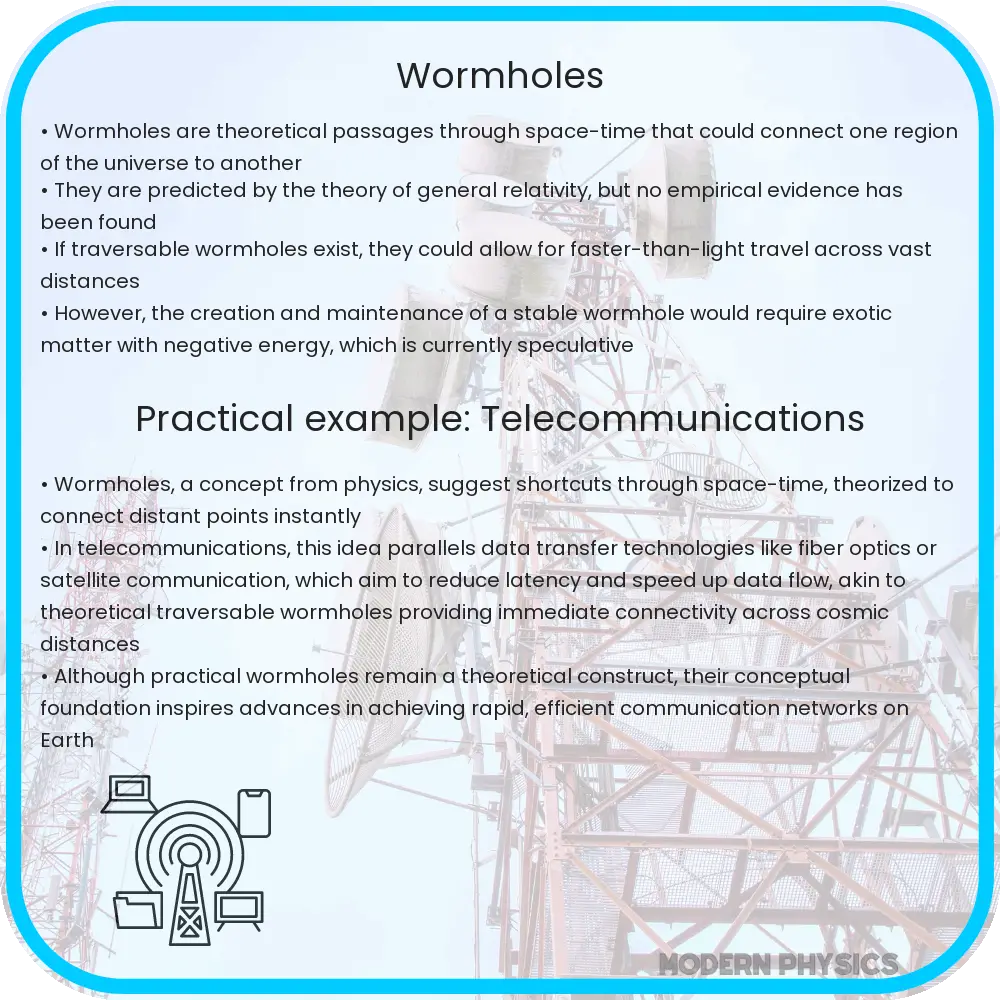Wormholes, hypothetical passages in space-time, potentially link distant universe points or different universes, based on Einstein’s theory of General Relativity.

Introduction to Wormholes
Wormholes, a popular concept in both science fiction and theoretical physics, captivate the imagination with possibilities of shortcuts through space and time. Originating from the equations of Albert Einstein’s theory of General Relativity, wormholes, or ‘Einstein-Rosen bridges’ as they are technically known, are hypothetical passages through space-time that could potentially connect two distant points in the universe, or more intriguingly, two different universes.
Understanding Wormholes and General Relativity
General Relativity is a profound scientific theory proposed by Albert Einstein in 1915, which describes gravity not as a conventional force, as Isaac Newton did, but as a curvature of space-time caused by mass and energy. According to Einstein’s field equations:
Eμν = (8πG/c4)Tμν
Here, Eμν represents the curvature of space-time, G is the gravitational constant, c is the speed of light, and Tμν is the stress-energy tensor that encapsulates the distribution of mass and energy. What’s fascinating about these equations is how they allow for solutions that include wormholes under certain conditions.
Theoretical Foundations of Wormholes
The concept of wormholes emerged from the Schwarzschild solution to Einstein’s equations, presented by Karl Schwarzschild in 1916. This solution describes the space-time structure around a spherical non-rotating mass like a static star or a black hole. Interestingly, an extension of the Schwarzschild solution hinted at the existence of ‘bridges’ or ‘tunnels’ connecting two separate points of space-time. However, these early interpretations required what’s known as the ‘Einstein-Rosen bridge,’ which collapses too quickly for anything to travel through.
Modern Theoretical Insights
In the 1980s, physicist Kip Thorne and his colleagues at Caltech revisited the idea of traversable wormholes. They proposed that with the presence of ‘exotic matter’—a hypothetical substance with negative energy density—it might be possible to stabilize a wormhole’s throat (the narrowest part of the wormhole connecting two regions of space-time) enough to allow for safe passage. This exotic matter would theoretically defy the usual energy conditions required by general relativity and thus keep the wormhole open.
The main equation describing the throat of a stable traversable wormhole can be expressed as:
Rμνρσ kμ kν kρ kσ ≥ 0
where Rμνρσ is the Riemann curvature tensor and k represents the directional vectors along the wormhole’s throat. This inequality shows the requirement for the curvature to maintain a non-negative value to allow the passage.
Physical and Philosophical Implications
The existence of traversable wormholes would have profound implications not only for physics but for our understanding of the universe itself. They could potentially allow for faster-than-light travel and instant communication across vast cosmic distances, presenting exciting yet daunting challenges and opportunities for future exploration and scientific investigation.
Moreover, if wormholes could indeed connect different universes, they might provide a physical basis for multiverse theories, which suggest that numerous independent universes might coexist with different laws of physics potentially operating in each.
Further exploration into wormholes could also impact philosophical questions about causality and the nature of time. The possibility of time travel through wormholes, while still highly speculative, raises discussions about paradoxes such as the famed “grandfather paradox,” where a time traveler could potentially prevent their own existence by altering the past.
Experimental Search and Challenges
Despite the thrilling theoretical possibilities, the physical existence of wormholes remains unconfirmed. Current experimental efforts in physics do not yet allow us to directly detect or create wormholes, but certain phenomena, such as gravitational lensing, provide potential indirect clues. Gravitational lensing occurs when a massive object bends the path of light passing near it, which could theoretically indicate the presence of a wormhole if observed under the right conditions.
Furthermore, the creation of a stable, traversable wormhole would require technology and energy scales that are currently beyond human capability. Theoretical calculations suggest that harnessing the power equivalent to a star would be necessary to open and maintain a wormhole, presenting not only a technical challenge but also raising ethical and safety considerations.
Potential Applications and Ethical Considerations
The realization of wormholes could revolutionize space travel and communication. Imagine being able to travel to distant galaxies within a human lifetime or sending information instantaneously across the universe. These are not just dreams but potential future applications that could change the course of human civilization profoundly.
However, with such power comes great responsibility. The ethical implications of wormhole technology are vast and complex. Who controls these wormholes? How do we prevent misuse or catastrophic accidents? These questions are just as critical as the scientific challenges and must be addressed by future generations if wormholes move from theoretical constructs to practical realities.
Conclusion
Wormholes, as predicted by general relativity and further explored by modern physicists, remain one of the most fascinating and enigmatic concepts in theoretical physics. While still within the realm of theory and far from empirical validation, wormholes inspire not only awe and wonder but also important discussions about the future of science, technology, and the fundamental understanding of our universe. Whether wormholes will eventually be proven real and traversable, or remain flights of theoretical fancy, studying them challenges our perceptions of reality and pushes the boundaries of human knowledge and capability.
